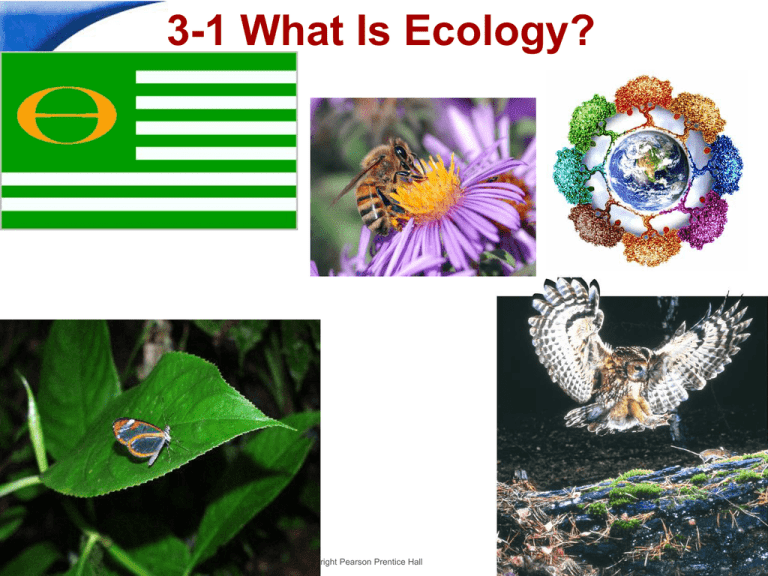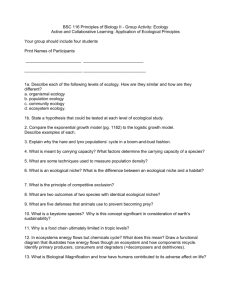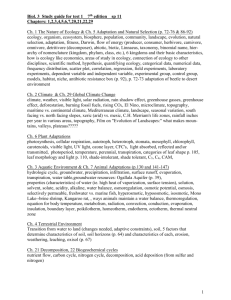
3-1 What Is Ecology?
Slide
1 of 21
Copyright Pearson Prentice Hall
End Show
3-1 What Is Ecology?
Interactions and Interdependence
Interactions and Interdependence
Ecology is the scientific study of interactions
among organisms and between organisms and
their environment, or surroundings.
Slide
2 of 21
Copyright Pearson Prentice Hall
End Show
3-1 What Is Ecology?
Interactions and Interdependence
Biosphere portions of the planet in which all of life
exists
• land
• water
• air, or atmosphere
Slide
3 of 21
Copyright Pearson Prentice Hall
End Show
3-1 What Is Ecology?
Interactions and Interdependence
The interdependence of life on Earth contributes to
an ever-changing, or dynamic, biosphere.
Slide
4 of 21
Copyright Pearson Prentice Hall
End Show
3-1 What Is Ecology?
Levels of Organization
What different levels of organization do
ecologists study?
Slide
5 of 21
Copyright Pearson Prentice Hall
End Show
3-1 What Is Ecology?
Levels of Organization
Levels of Organization
The levels of organization that
ecologists study include:
–Individuals (Species)
–Populations
–Communities
–Ecosystems
–Biomes
Slide
6 of 21
Copyright Pearson Prentice Hall
End Show
3-1 What Is Ecology?
Levels of Organization
Biosphere
Biome
Ecosystem
Community
Population
Individual
Slide
7 of 21
Copyright Pearson Prentice Hall
End Show
3-1 What Is Ecology?
Ecological Methods
What methods are used to study ecology?
Slide
8 of 21
Copyright Pearson Prentice Hall
End Show
3-1 What Is Ecology?
Ecological Methods
Ecological Methods
Regardless of the tools they use, scientists
conduct modern ecological research using three
basic approaches:
• observing
• experimenting
• modeling
Scientific methods guide ecological inquiry.
Slide
9 of 21
Copyright Pearson Prentice Hall
End Show
3-1 What Is Ecology?
Ecological Methods
Observing
Observing is often the first step in asking
ecological questions.
•Simple or complex.
Slide
10 of 21
Copyright Pearson Prentice Hall
End Show
3-1 What Is Ecology?
Ecological Methods
Experimenting
Experiments can be used to test a hypotheses.
Artificial environments imitate and can be
manipulated.
Natural Ecosystems – (Pros/Cons)
Slide
11 of 21
Copyright Pearson Prentice Hall
End Show
3-1 What Is Ecology?
Ecological Methods
Modeling
Ecologists make models to gain insight into
complex phenomena.
Slide
12 of 21
Copyright Pearson Prentice Hall
End Show
3-1
Click to Launch:
Continue to:
- or -
Slide
13 of 21
End Show
Copyright Pearson Prentice Hall
3-1
The combined portions of the planet in which life
exists, including land, water, and the
atmosphere, form the
a. biosphere.
b. community.
c. species.
d. ecosystem.
Slide
14 of 21
End Show
Copyright Pearson Prentice Hall
3-1
A group of organisms that can breed and
produce fertile offspring is known as a(an)
a. ecosystem.
b. species.
c. biome.
d. community.
Slide
15 of 21
End Show
Copyright Pearson Prentice Hall
3-1
Compared to a community, an ecosystem
includes
a. the nonliving, physical environment as well
as the community.
b. only the physical environment of an area
without the organisms.
c. the entire biome but not the biosphere.
d. only one of the populations within the
community.
Slide
16 of 21
End Show
Copyright Pearson Prentice Hall
3-1
An ecological method that uses mathematical
formulas based on data collected is
a. observing.
b. experimenting.
c. modeling.
d. hypothesizing.
Slide
17 of 21
End Show
Copyright Pearson Prentice Hall
3-1
An ecologist marks out an area in a specific
ecosystem and proceeds to identify the number
of insect species in the area. This is an example
of ecological
a. experimentation.
b. observation.
c. modeling.
d. inference.
Slide
18 of 21
End Show
Copyright Pearson Prentice Hall
END OF SECTION









